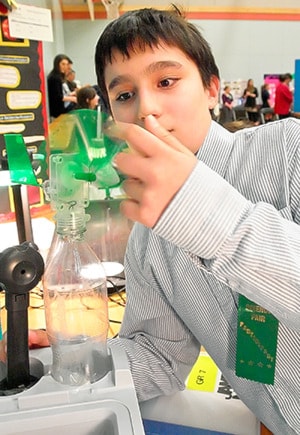James Nemes wasn’t just interested in winning the district science fair. He wants to make some big changes in the world.
Inspired by startling images on TV showing the decline of the polar bear problem due to shrinking ice caps, the Grade 7 student put together a project demonstrating a method of creating more ice.
“My project is to build a platform that the polar bears can live and hunt on, because if they can’t hunt, they just die of starvation,” said Nemes, who is a home learner, telling of documentaries that showed the polar bears on thin sheets of ice. “Another one I saw was a baby cub and its mother. The baby cub died, he just couldn’t take it anymore. Eventually the mother died.”
Nemes was one of the many students whose work was on display Monday at KVR Middle School for the District Science Fair.
Using a portable electric cooler, Nemes project demonstrates the concept of creating floating platforms using wind and solar energy to provide power for the refrigeration unit.
“I noticed in my experiment that the wind energy is a little better than solar energy, because the solar energy has to recharge. Wind energy can just keep going and going,” explained Nemes.
“For me the biggest thing I see is that whole environmental piece, kids asking questions,” said Summerland Middle School principal Katie Hicks, who was judging projects at the fair. “I just judged a project on using grey water and recycling that water in our homes.”
Hicks was excited to see many of the projects looking into environmental issues, and, like Nemes, demonstrating their global awareness. She explained that teaching students how to investigate and explore the subjects they were interested in was one of the most important things about the science fair.
“It allows them to determine what is of interest to them, do the research, do the reading, do the work and then present what they find,” agreed Raja Gupta, who organizes the annual fair. “From a very unique standpoint, some of these kids become experts in their particular field.”
Gupta said this year’s projects, 88 of them altogether, were particularly impressive.
“The depth of the projects is a little stronger,” he said.
Besides teaching science at Summerland Secondary, Gupta also plays the guitar and found himself drawn to one student project in particular.
“This guy over here made his own guitar pickups. At some point I will wander over and pick his brain on how to make my guitar sound better.”
Alongside the science, another important part of the science fair is the students learning to communicate their passion and explain the project to others.
“We have some amazing projects come out of basements and bedrooms. For them to be able to speak publicly about what they have done and be able to articulate that, that is very big in science,” he said. “Who knows where any of these kids are going to be down the road, but they are public speaking at the age of 12, 13, 14. Complete strangers are walking up to them and they are being evaluated on their presentation and their work.”
Even if a small percentage continues on with work in science, Gupta said the teachers have accomplished something with these students.
“It’s like anything, if you get one person to remember one thing about something you have done … you’ve done your job,” said Gupta.
